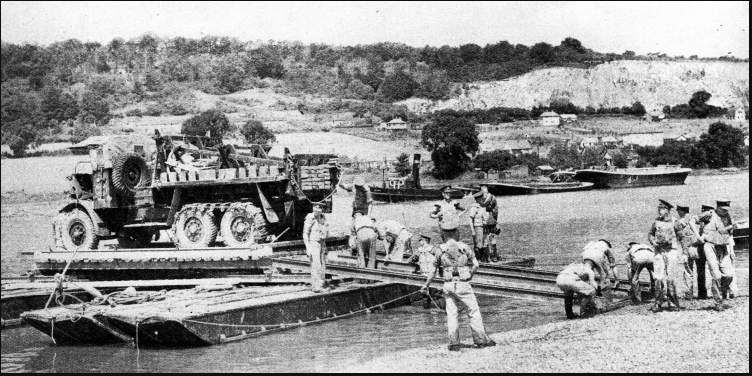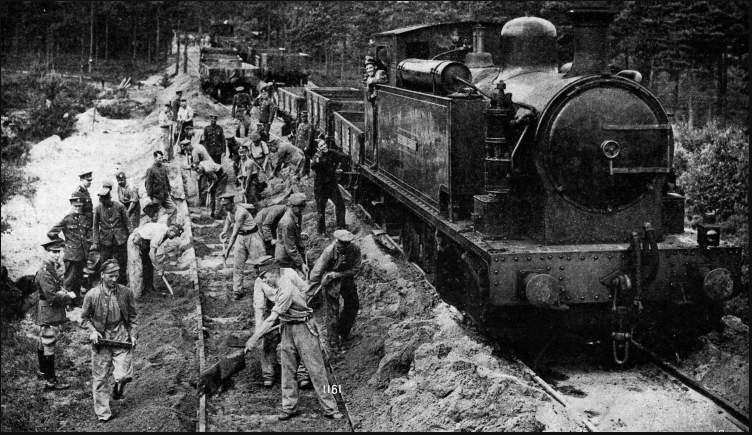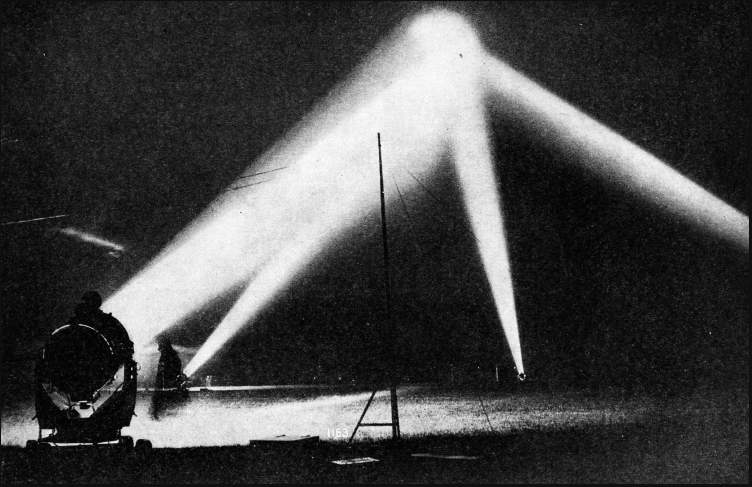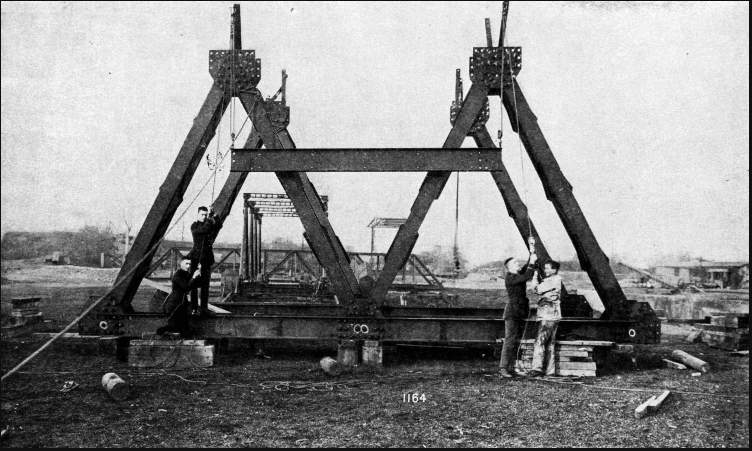|
|
Engines of war are no new invention, and attempts at the mechanization of armed forces were made many ages ago in man's struggle for power. The scythes on ancient British chariots, the siege engines of the Romans, the armour of medieval knights, the application of gunpowder—all represent steps in the slow development of warfare through the centuries. Now the day of the sword and spear has ceased and the defence of countries depends on the accuracy of scientific calculations and on industrial resources. The struggle now lies on either side between men and machines, and military engineering is of as much importance as the courage and resolution of the fighting units and the efficiency of industry mobilized for war. In the British Army the vast amount of engineering work entailed in the theatre of war, from trench construction to road and railway building, is undertaken by the Corps of Royal Engineers. Among the earliest examples of military engineering in Great Britain were the great roads built by the Romans to facilitate the movements of their legions. To-day, roadmaking is one of the most important of all military engineering activities in time of war. Mechanization can have little value without good roads. Earthworks and other forms of fortification called for specialized attention even in the earliest times. By the beginning of the eighteenth century, after the establishment of an English standing army, a number of "King's Engineers" had been appointed for special duties, mainly in connexion with fortifications. In 1700 there were twelve of these officials (they did not hold army rank) in the British Isles, but long before then the country's wars had necessitated the services of "Train Engineers" for the operation of the cannon and the supply of ordnance. The artillery, however, was separately established in 1716 and a Corps of Engineers was formed with a permanent personnel, augmented in war time, of twenty-eight engineers. A Company of Soldier Artificers was formed at Gibraltar in 1772, and these men played an important part in the siege of the Rock (1779-83) and in the building of the first of the famous gun galleries. The Corps of Engineers was granted the title of "Royal" in 1787 and in that year also was formed a Corps of Royal Military Artificers, in which the Soldier Artificers were afterwards incorporated. The Artificers were responsible for Wellington's famous fortifications, the Lines of Torres Yedras, before Lisbon in the Peninsular War. In 1813 the Royal Military Artificers were renamed the Royal Sappers and Miners. A private soldier in the Royal Engineers is still termed a sapper and a sap is the name given to a heading run out from a trench dug parallel with a line of fortifications to be attacked. The Royal Sappers and Miners performed invaluable work at the siege of Sebastopol and elsewhere during the Crimean War. At the conclusion of hostilities in 1856 the Royal Sappers and Miners (which consisted of rank and file only to this date) were united to the existing Corps of Royal Engineers. The East India Company's Engineer officers, with the traditions of Lucknow and the storming of Delhi well Established in British history, were amalgamated with the Corps of Royal Engineers in 1862.
Although the term "civil engineer" is now restricted to engineers engaged on structures such as bridges, railways, docks and so forth, the term was coined originally to distinguish non-military engineers from the Royal Engineers. The Institution of Civil Engineers was founded in 1820. With the expansion of the British Empire during the last century the work of the Royal Engineers increased enormously in size and scope. Just as the artillery was given a separate establishment as early as 1716, this form of specialization, with the Royal Engineers as originator, has been going on ever since. Army signalling is a particularly interesting example of specialization in military engineering. The first field telegraph was used by the Royal Engineers during the Crimean War, and R.E. Companies were later formed to operate overhead and underground cables for telegraphy and telephony. In due course radiotelegraphy made its appearance, and its immense advantages for military purposes were quickly recognized. In 1911 these special companies were known as the Army Signal Services R.E., and in the war of 1914-18 they were organized as Signal Companies R.E. After the war, however, signalling had attained so advanced a stage of development that the separate Royal Corps of Signals was formed. Signalling is vitally important in military operations and few branches of field engineering exhibit such variety of work and equipment. In time of war the whole battle area must be closely linked by a network of telephone wires extending from the front line to the various battalion, brigade, divisional and army headquarters. The close linking of all forward positions by telephone with supporting artillery batteries is essential for the purpose of ranging or for a barrage in the event of an attack. The maintenance of the wires requires the utmost skill and courage. Communication between the front line and supports must be maintained at all costs, and repeated wire breaks must be repaired immediately, generally under heavy fire. Specialized ServicesOne important aspect of " front line " telephony is the possibility of the enemy listening in to orders and conversations, by induction, from his own trenches. Special precautions have to be taken to ensure secrecy, and listening instruments and operators conversant with the enemy's language are installed to glean information from the opposing side. It is military communication by radio, however, that provides some of the more spectacular aspects of signalling. Military radio stations range from the semi-permanent buildings at the various bases to the portable transmitters and receivers that can be carried on mules or in light wagons. Signalling, however, is by no means the only specialized service that originated in the Corps of Royal Engineers. Coast defence by electrically fired submarine mines was once an R.E. task. Companies of Royal Engineers were formed for this purpose in 1871, but in 1905 the work was handed over to the Royal Navy. The military engineer was responsible also for the use of aircraft in the conduct of hostilities. As early as 1884 balloons were used in Bechuanaland for observation purposes and an R.E. Balloon Depot was established at Alder-shot, Hants, in 1890. In 1911 an Air Battalion R.E. was formed and a year later saw its separation as the Royal Flying Corps, later to become the Royal Air Force. Mechanical transport in the British Army Was evolved from the steam tractors used by the 45th Company of Royal Engineers in the Boer War. Further development vested the transport services of the army in the Royal Army Service Corps.
The Royal Tank Corps owes its inception to a Royal Engineer officer, now Major-General Sir Ernest Swinton, K.B.E., C.B., D.S.O., who commanded during their first attack in 1916 the new machines he had done so much to introduce. The tank was the mechanized answer to the trench system with its fields of barbed wire and its carefully concealed machine guns. During the war of 1914-18 the work of the Royal Engineers was extended in a remarkable manner as new methods of warfare were introduced from time to time. When the enemy began to use gas it fell to the R.E. to devise defensive measures and to provide means of retaliation. Tunnelling Companies were raised in ever-increasing numbers and mining was started on a scale that never before had been attempted in warfare. At the capture of Messines Ridge, Belgium, in June 1917, nearly 1,000,000 lb. of explosives. were fired under the enemy trenches. This great task involved months of patient preparatory work and the boring of tunnels for hundreds of yards. In any campaign adequate supplies of drinking water are an absolute necessity, and here again the sinking of wells and boreholes is done by the Royal Engineers. During the Palestine Campaign in 1914-18 the R.E. laid a water pipe line across the desert from the Nile for a distance of 150 miles—no light task even in peace time. Water is at the same time a necessity and a serious military obstacle. Among the most important tasks of the army engineer are bridge building when advancing and demolition in retreat. Military bridges differ from most others in that they are for temporary use and they must be capable of being taken down for rapid transport and rebuilding elsewhere. There is no hard and fast rule about this, however. During the last three months of the war of 1914-18 the Royal Engineers built 326 steel-girder bridges in France alone. Temporary bridges used for military purposes are generally built of timber, as these can sometimes be formed from materials on the spot, such as trees and fence rails lashed together with rope, though steel structures are used also. Instant AssemblyTimber lashed with rope may appear somewhat inadequate as material for bridges designed to carry guns and limbers, supply columns and battalions of marching men under arms ; but the timber and rope that have served in so many campaigns provide an immensely strong type of bridge. Every rope lashing is counterlashed with rope termed "frapping turns" (from the French frapper—to hit), and the rope is beaten into place by hammer blows. The shrinking of the lashings as they become wet makes the structure even more secure. Military bridging sometimes requires only the simplest of materials, as for instance, rafts made of petrol tins. Generally, however, the floating type of bridge is built on the transportable steel pontoon sections that are capable of instant assembly into boats of any required length, according to the load to be carried. With the necessary number of boats securely anchored across the rivers the plank roadway is rapidly pushed across from the bank. In addition to the pontoon bridge, the steel-girder bridge is highly important for securing the passage of mechanized units. Among such bridges is the Hopkins bridge, which is bolted together at the site. No component weighs more than 10-1/2 cwt., but spans up to 180 feet are used and the structure is capable of carrying a 35-tons tank. A steel bridge that requires no bolting is the Inglis bridge, in which steel tubes are used and all joints are made with special junction boxes at the ends of the transoms and struts. To ensure safety, the tubes are secured in the junction boxes by pins and split-pins. This type of bridge is assembled on the river bank and is then swung across the water on a special pivot.
The essence of all such construction is speed, and in most instances the work has to be carried out under heavy fire from the rearguard of the enemy. The numerous types of bridge thrown by the engineers across rivers and streams range from light footbridges to massive structures capable of carrying the largest tanks and the heaviest guns. Shallow streams and narrow crossings are negotiated by trestle or cantilever bridges. Wide crossings and deep, swift rivers require bridges of the floating type built on rafts, barrels, commandeered boats and barges, or on the pontoons that are under the control of special R.E. companies known as Pontoon Bridge Parks. Bridge demolition is yet another task involving considerable risk. Essential in retreat, the destruction of bridges can be accomplished only at the last available moment, when the rearguard troops have safely crossed the river or stream. Hence the work must often be carried out in face of heavy fire from the enemy. Hasty though demolition may be, however, the amount of explosive used must not exceed the quantity necessary to destroy the bridge. Explosives are too precious in retreat to be used wastefully. The method of firing explosives for demolition purposes are similar to those used in peace time for blasting. The skill of the demolition engineer is exhibited also in the choice of the correct location for the explosive charge to ensure complete destruction. In this matter, however, the military engineer is often assisted by the bridge builder. It is not generally known, but large numbers of bridges, especially railway structures, built in districts liable to invasion by a foreign power, are provided with "demolition chambers." These pierce the masonry piers in the form of narrow shafts extending well below water level. Steel lattice girder bridges are provided with "boxes" built into the girder work at the correct places for complete destruction and capable of holding the right amount of explosive. Arteries of an ArmyRailway demolition calls for a technique of its own and methods range from the leisurely removal of whole sections of rail to the hasty shattering of a rail here and there. Points and crossovers are favourite places for the latter method of destruction, which consists of tying a slab of guncotton to the side of the rail with primer and detonator duly in place. The fuse is then lit and the retreat is continued without delay. Any train advancing along the track then meets a gap of some eighteen inches in the rail. It is railway building, however, that occasions some of the heaviest work in military engineering. War recognizes no rights of way and the railways required for army purposes are generally laid in positions where, ordinarily, no line would be built. The track must be laid, certainly in intensive warfare, at the highest possible speed and its function is to link the various artillery and other "parks" with the existing railways and with the vast dumps of ammunition and stores of all kinds. These additional standard-gauge railways, extending some distance behind the trench systems and designed for heavy traffic, do not represent the last word in military railway construction. When a campaign has developed into trench warfare one of the most important means of communication for the transport of supplies between support and front-line trenches is the light railway, generally laid with wooden rails. Wooden trucks with iron wheels are built to run by "push power" along these wooden ways, bringing to the front line every conceivable kind of requisite for the waging of war.
Hundreds of miles of such miniature railways were built by the Royal Engineers during the war of 1914-18, and their operation was unorthodox throughout. Almost all traffic passed at night, but the only signals seen were the star shells and flares—signals that always spelt "stop" to the experienced. Whole sections of such railways would be shelled out of existence by day and by night and the necessity for railway replacements would then present the Royal Engineers with yet another dangerous but essential task. Although defence trenches are generally made by infantry, the Royal Engineers are called upon to build deep dugouts and to carry out any concrete work that may be necessary. Often, however, the Royal Engineers will be required to elaborate a system of trenches. Dugouts and shelters may be simple caves cut into the trench sides and roofed with corrugated iron and sandbags, or they may be dug deep into the ground and provided with bunks and even with electric light. In support of the field companies of Royal Engineers there are numerous other units of the Corps at the various army bases. Here there are electrical and mechanical companies, workshops, stores, and transportation units for the building and operation of docks and railways. Such companies are not necessarily confined to bases, however. Quarrying companies are also part of the Corps of Royal Engineers. The postal units of the R.E. run the whole of the field army's postal services in war time. Within the scope of military engineering also are the Royal Engineers' anti-aircraft battalions and searchlight units, of supreme importance in view of the aeroplane's remarkable development in speed, range and power of destruction. These battalions form the largest part of the Royal Engineers peace organization. Apart from the anti-aircraft work, the Royal Engineers attend in defended ports to the searchlights which illuminate targets on the sea. Ordnance SurveyThe use of aeroplanes, airships and observation balloons has led to remarkable developments in yet another phase of military engineering—the art of camouflage. To escape destruction in war time everything that may be regarded by the enemy as a worth-while target must be hidden with the most scrupulous care. Any works that can be identified through the powerful glasses of observers in the air or on the ground are marked down for attack. An even greater danger than the visual observer, however, is the aerial camera. From an aeroplane it is possible to photograph enormous stretches of country and the camera detects far more than the keenest eye. Trenches cannot often be adequately camouflaged, but gun pits and similar important positions can be hidden under netting covered with leaves or similar material that will merge readily with the surroundings. Dummy guns, tanks and even troops provide another outlet for engineer activity and serve to deceive the enemy as to the intended point of attack and draw his fire. The mechanization of warfare, however, begins far behind the great bases. In the workshops and factories craftsmen and designers work unceasingly on the production of guns and shells, tanks and armoured cars, and the thousands of mechanical devices required in modern war. Other activities of the Royal Engineers include surveying and mapping. The Survey of India is manned principally and the Ordnance Survey of Great Britain wholly by Royal Engineers. In war, the field survey companies make and print maps and fix points to assist the Royal Artillery. The construction and maintenance of War Department roads and buildings is an important branch of the Royal Engineers' activities. In this way R.E. officers get an insight into many kinds of civil engineering. The army requires a vast amount of civil engineering work, and the training in works in peace enables the R.E. officer to organize this work and to co-operate with other engineers.
Many thanks for your help
|
   Share this page on Facebook - Share  [email protected] |









